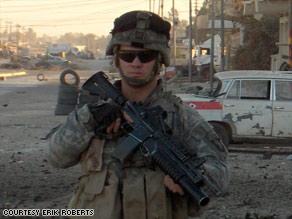 (Photo: Urban Space Management)
(Photo: Urban Space Management)Invented more than five decades ago, the modern shipping container is the linchpin in our global distribution network of products. In the containers go toys from China, textiles from India, grain from America, and cars from Germany. In go electronics, chocolate, and cheese.
While a number of resourceful people have converted shipping containers into make-shift shelters at the margin of society for years, architects and green designers are also increasingly turning to the strong, cheap boxes as source building blocks.
Shipping containers can be readily modified with a range of creature comforts and can be connected and stacked to create modular, efficient spaces for a fraction of the cost, labor, and resources of more conventional materials.
Discover some of the exciting possibilities of shipping container architecture, from disaster relief shelters to luxury condos, vacation homes, and off-the-grid adventurers. See what makes them green as well as cutting edge.
 (Photo: Andre Movsesyan / DeMaria Design )
(Photo: Andre Movsesyan / DeMaria Design )De Maria Design Redondo Beach House
With its modern lines and appealing spaces, the award-winning Redondo Beach House by De Maria Design turns heads. The luxury beach-side showpiece was built from eight prefabricated, recycled steel shipping containers, along with some traditional building materials. According to the architects, the modified containers are "nearly indestructible," as well as resistant to mold, fire, and termites. Seventy percent of the building was efficiently assembled in a shop, saving time, money, and resources.
One of the containers can even sport a pool! The lessons learned from Redondo Beach House are being incorporated into a line of more affordable, accessible designs, soon available as Logical Homes.
 (Photo: Urban Space Management)
(Photo: Urban Space Management)London's Container City
Conceived by Urban Space Management, London's Container City first sprang up in the heart of the Docklands in 2001. It took just five months to complete the original 12 work studios, at a height of three stories. Shortly after that a fourth floor of studios and living apartments was added.
Container City was designed to be low cost, as well as environmentally friendly. Recycled materials made up 80% of building supplies. Architect Nicholas Lacey and partners and engineer Buro Happold used component pieces to build up adaptable living and work spaces.
 (Photo: Kool-Kini / Flickr )
(Photo: Kool-Kini / Flickr )Container City II
Container City I was a success, and in2002, Urban Space Management added an addition, dubbed Container City II. Reaching five stories high, Container City II is connected to its earlier iteration via walkways. It also boasts an elevator and full disabled access, as well as 22 studios.
 (Photo: Paul McCredie)
(Photo: Paul McCredie)Port-a-Bach
Need some flexibility with security? Need a temporary structure or small vacation home? Going off the grid? The Port-a-Bach system from New Zealand's Atelier Workshop might be a good fit.
Costing around $55,000, Port-a-Bach sleeps two adults and two children comfortably, in a dwelling that folds up into a fully enclosed steel shell. It comes with large internal storage cupboards and shelves; a stainless steel kitchen; bathroom with shower, sink and composting toilet; bunk beds and dressing room. Fabric screens allow you to shape internal space, as well as shelter the outdoor deck area.
Bach (pronounced Batch) is Kiwi slang for "Bachelor Pad," and refers to the many small cabins that dot the famously picturesque country.
 (Photo: Urban Space Management)
(Photo: Urban Space Management)Cove Park Artists' Retreat
Set on 50 acres of gorgeous Scottish countryside, Cove Park is an artist's retreat designed to stimulate and reinvigorate. Urban Space Management first brought in three repurposed shipping containers in 2001, and the center became so popular that more units have been added.
Doesn't look like your average shipping box, does it?
 (Photo: Bark Design Collective)
(Photo: Bark Design Collective)
All Terrain Cabin
Canada's Bark Design Collective built the All Terrain Cabin (ATC) as a showcase for sustainable (and Canadian!) ingenuity. The small home is based on a standard shipping container, and is said to be suitable for a family of four, plus a pet, to live off the grid in comfort and style.
The cabin folds up to look like any old shipping container, and can be sent via rail, truck, ship, airplane, or even helicopter. When you're ready to rest your bones, the cabin quickly unfolds to 480 square feet of living space, with a range of creature comforts.
Invented more than five decades ago, the modern shipping container is the linchpin in our global distribution network of products. In the containers go toys from China, textiles from India, grain from America, and cars from Germany. In go electronics, chocolate, and cheese.
While a number of resourceful people have converted shipping containers into make-shift shelters at the margin of society for years, architects and green designers are also increasingly turning to the strong, cheap boxes as source building blocks.
Shipping containers can be readily modified with a range of creature comforts and can be connected and stacked to create modular, efficient spaces for a fraction of the cost, labor, and resources of more conventional materials.
Discover some of the exciting possibilities of shipping container architecture, from disaster relief shelters to luxury condos, vacation homes, and off-the-grid adventurers. See what makes them green as well as cutting edge.
 (Photo: Andre Movsesyan / DeMaria Design )
(Photo: Andre Movsesyan / DeMaria Design )De Maria Design Redondo Beach House
With its modern lines and appealing spaces, the award-winning Redondo Beach House by De Maria Design turns heads. The luxury beach-side showpiece was built from eight prefabricated, recycled steel shipping containers, along with some traditional building materials. According to the architects, the modified containers are "nearly indestructible," as well as resistant to mold, fire, and termites. Seventy percent of the building was efficiently assembled in a shop, saving time, money, and resources.
One of the containers can even sport a pool! The lessons learned from Redondo Beach House are being incorporated into a line of more affordable, accessible designs, soon available as Logical Homes.
 (Photo: Urban Space Management)
(Photo: Urban Space Management)London's Container City
Conceived by Urban Space Management, London's Container City first sprang up in the heart of the Docklands in 2001. It took just five months to complete the original 12 work studios, at a height of three stories. Shortly after that a fourth floor of studios and living apartments was added.
Container City was designed to be low cost, as well as environmentally friendly. Recycled materials made up 80% of building supplies. Architect Nicholas Lacey and partners and engineer Buro Happold used component pieces to build up adaptable living and work spaces.
 (Photo: Kool-Kini / Flickr )
(Photo: Kool-Kini / Flickr )Container City II
Container City I was a success, and in2002, Urban Space Management added an addition, dubbed Container City II. Reaching five stories high, Container City II is connected to its earlier iteration via walkways. It also boasts an elevator and full disabled access, as well as 22 studios.
 (Photo: Paul McCredie)
(Photo: Paul McCredie)Port-a-Bach
Need some flexibility with security? Need a temporary structure or small vacation home? Going off the grid? The Port-a-Bach system from New Zealand's Atelier Workshop might be a good fit.
Costing around $55,000, Port-a-Bach sleeps two adults and two children comfortably, in a dwelling that folds up into a fully enclosed steel shell. It comes with large internal storage cupboards and shelves; a stainless steel kitchen; bathroom with shower, sink and composting toilet; bunk beds and dressing room. Fabric screens allow you to shape internal space, as well as shelter the outdoor deck area.
Bach (pronounced Batch) is Kiwi slang for "Bachelor Pad," and refers to the many small cabins that dot the famously picturesque country.
 (Photo: Urban Space Management)
(Photo: Urban Space Management)Cove Park Artists' Retreat
Set on 50 acres of gorgeous Scottish countryside, Cove Park is an artist's retreat designed to stimulate and reinvigorate. Urban Space Management first brought in three repurposed shipping containers in 2001, and the center became so popular that more units have been added.
Doesn't look like your average shipping box, does it?
 (Photo: Bark Design Collective)
(Photo: Bark Design Collective)All Terrain Cabin
Canada's Bark Design Collective built the All Terrain Cabin (ATC) as a showcase for sustainable (and Canadian!) ingenuity. The small home is based on a standard shipping container, and is said to be suitable for a family of four, plus a pet, to live off the grid in comfort and style.
The cabin folds up to look like any old shipping container, and can be sent via rail, truck, ship, airplane, or even helicopter. When you're ready to rest your bones, the cabin quickly unfolds to 480 square feet of living space, with a range of creature comforts.
http://green.yahoo.com/blog/daily_green_news/8/twelve-amazing-shipping-container-houses.html

















 The Raging Grannies defy just about every stereotype our culture has about older women. They are politically active, intellectually sharp, unapologetic about their opinions and willing to do just about anything to get their message of peace and social justice out into the world. These are women who aren't ashamed they've been around the block a few times, and are ready and willing to apply some of the important life lessons they have learned along the way. Lesson No. 1 is that a hilarious ditty often catches a lot more ears than an angry chant. The group recently sang their social justice hearts out at a rally they organized to protest the passage of California's Proposition 8:
The Raging Grannies defy just about every stereotype our culture has about older women. They are politically active, intellectually sharp, unapologetic about their opinions and willing to do just about anything to get their message of peace and social justice out into the world. These are women who aren't ashamed they've been around the block a few times, and are ready and willing to apply some of the important life lessons they have learned along the way. Lesson No. 1 is that a hilarious ditty often catches a lot more ears than an angry chant. The group recently sang their social justice hearts out at a rally they organized to protest the passage of California's Proposition 8:







